Lisa Niver's Blog: We Said Go Travel, page 411
March 12, 2014
Cradle Mountain, Australia
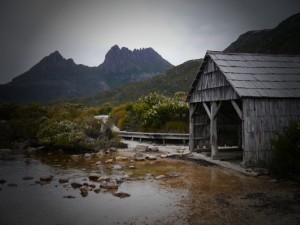 I almost made it to the top of Cradle Mountain once. Time defeated me, and some misty rain that coated the rocks with a fine wet slick. There’s a bit of rock scrambling to make it to the very top of this cradle-shaped dolomite mountain in the Tasmanian wilderness.
I almost made it to the top of Cradle Mountain once. Time defeated me, and some misty rain that coated the rocks with a fine wet slick. There’s a bit of rock scrambling to make it to the very top of this cradle-shaped dolomite mountain in the Tasmanian wilderness.
However, it’s not as difficult as you might think to visit Cradle Mountain and the national park that surrounds it. The park entrance is about a two hour drive from the nearest international airport, at Launceston, Tasmania. And there’s also a luxury-meets-rustic lodge to stay at, right on the edge of the park, with great Tassie food and wine, and a divine spa. You might even learn to say ‘Tassie’ like the locals.
The Tasmanian wilderness is one of the last places where almost anyone can experience the timelessness of an ancient, untouched land. You don’t have to be a mountain climber or extreme hiker to take the track up to Marion’s Lookout and on to Kitchen Hut at the base of the mountain, or even to tackle the track up to the top. These are day hikes for reasonably fit people. The tracks cross button grass plains, pass wombat burrows, climb through temperate rain forests and meander across sub-alpine meadows. They pass rushing snow-melt streams, waterfalls, mountain tarns and lakes, the water stained to a dark tea colour by the tannin in the button grass. And the water is clean, clear, cold and drinkable. Unpolluted, pure – water from past ages. For enthusiastic trekkers, Cradle Mountain is the start of the famous five-day Overland Track. For the less mobile, even half an hour on the lodge’s ‘Enchanted Stroll’ will discover ancient beeches covered in moss, quietly living beside the stream, disturbed by nothing except the wildlife.
Dove Lake spreads picturesquely at the base of Cradle Mountain and it’s possible to circumnavigate it on a walk that takes about three hours. Hidden, rough paths lead up into the barely-explored bush. A walk through the Ballroom Forest is a walk into the past. It’s a moss-coloured, sunlight-dappled forest of Tasmania’s unique trees. There’s myrtle, sassafras, Tasmanian blackwood and ancient King Billy pines up to 1500 years old. The hush in the air is thick and evocative. Harking back to the 1930s and 40s, a time before the roads were built and visitors came hiking in to the lake, is the old boat shed on the northwestern shore. The boat shed has weathered grey now. It’s restored from time to time, to make sure it doesn’t fall down, but is deliberately kept close to its original condition.
Cradle Mountain Lodge has stood at the edge of the national park for decades. Don’t expect a phone signal, or a television in your room. But do expect warm wood fires, gourmet food made from fresh Tasmanian ingredients, and a selection of activities like wildlife spotting at night, or canoeing on Dove Lake in the day time. To drink in the wilderness in blissful idleness, visit the spa and relax after your treatment in the outdoor jacuzzi. Sit in the warm water, feel the crisp cool air on your skin, crunch a Tasmanian apple, and gaze at the pencil pines, trees that were here long before, and will be here long after.
A few kilometres into the park stands Waldheim Chalet. Come here to muse on the life and achievements of an eccentric Austrian naturist named Gustav Weindorfer and his wife Kate who were the first Europeans to live in this place, in the early twentieth century. Consider the greying King Billy pine wood of the crude chalet, the now-cold embers in the old fireplace, the chill of the nights they spent here in winter, and the animals that wander in and out: wombats, pademelons, wallabies, quolls. At night, it’s possible to spot a Tasmanian Devil. This is their habitat. These unusual Tasmanian marsupials are a throwback to the time before time when the island was isolated from the mainland and its flora and fauna evolved silently and unknown to all, except its own indigenous people.
Weindorfer famously climbed to the summit of Cradle Mountain (unlike me), looked out at all he saw around him, and cried “ this must be preserved for all time!” His efforts saw the region proclaimed a national park, and he’s a local hero for it. There’s just something about the quiet alpine air, the ancient stillness of the moss-covered pencil pines, the odd lumbering wombat that strays across the path and the vigorous sweep of the mountain above. Weindorfer saved it for us all.
About the Author: Annette Freeman is a travel writer, author and blogger based in Sydney. Australia, but addicted to travel. Tasmania is her home state.
Thank you for reading and commenting. Please enter our next Travel Writing competition and tell your story.
The post Cradle Mountain, Australia appeared first on We Said Go Travel.
Invincible in Namibia
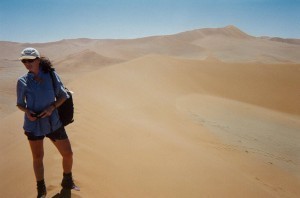 I pull the Polo up at the boom-gate beside tool-laden four-wheel-drives and battered campervans. My sister, Ro, and I step into the heat and scout our surroundings for the legendary sand dunes of Sossusvlai, but all we can see are the drab grey brown hills and specks of angry vegetation that we have already come to associate with the Namibian countryside.
I pull the Polo up at the boom-gate beside tool-laden four-wheel-drives and battered campervans. My sister, Ro, and I step into the heat and scout our surroundings for the legendary sand dunes of Sossusvlai, but all we can see are the drab grey brown hills and specks of angry vegetation that we have already come to associate with the Namibian countryside.
We stand akimbo in front of the sign: ‘No vehicles beyond this point,’ and then return to the car to retrieve the Lonely Planet from its spot in the passenger door. It outlines our options: walk the last four kilometers to the dunes or pay the five dollars to catch the shuttle.
After so many days in the car, we welcome the exercise. Besides, we don’t want to pay the five dollars. And so we load our daypacks with snacks and water, lather ourselves with sunscreen, pull our caps low over our sunglasses, and stride past the boom-gate.
The road is wide and rough, and as we trudge, it changes from sickly grey to rich ochre. When the mini-bus full of hot but happy tourists zip past, I cover my mouth with my hand, and Ro cloaks her face with a shirt sleeve, the white cotton already assuming a tinge of orange. We plod on, the silence between us voicing mutual concerns that our combined stubbornness might see us dead on the side of a dusty road.
The horizon rises towards us like a giant tangerine, and the orange roadside rolls like ribbons against the blue of the sky. Better, but not inspiring when the sun is so merciless. The shuttle zooms past again, the dust rising behind the wheels like magician’s smoke, and we turn our heads away and pull the necks of our t-shirts over our faces.
A picnic bench sheltered by a conspicuously fleshy tree jumps into view, and the white empty salt pan opens before us. The black skeleton of a second lonely tree dominates the scenery at the foot of the dunes.
Smirking with satisfaction, we guzzle water as we navigate our way across the crust and stop at the base of Sossusvlai Dune 45 rising like a sunburnt tsunami caught in a snapshot.
“It’s pretty big up close,” I say.
“Yep,” Ro agrees. “And this is one of the smaller ones.” She steps onto the sand and starts up the slope. The ridge lines are flawless. The dune folds its particles into the indentations created by her boots, and I shake my head at the fleeting thought that we might be disturbing this place.
Trudging up that sandy giant is exhausting. As I lag behind my sister, my lungs heave, and my legs wobble. I stop and start like a commuter train, and still, my sister strides ahead of me like Sir Edmond scaling Everest. If she can do it, so can I. I had learned long ago that this is not always true – there is plenty she can do that I can’t – but the sun sears my brain to beyond delusional.
Ro stands at the peak, her head high, and her hair whipping behind her, hands on her hips, weight on one leg, and the other knee bent toward the north: an explorer’s pose. She appears majestic against the brilliant blue, while I suck in oxygen and think I might die.
But when I reach her, I, too, stand like an explorer, a conqueror of mighty things, the wind too wild for us to be heard when we yell in each other’s ears about the magic. I survey the red hills and think of camel caravans, mysterious desert dwellers, and Lawrence of Arabia. Okay, so Namibia is a long way from Arabia, but the immensity is mind-blowing. I am on top of the world and invincible.
“You go down first and I’ll take photos,” Ro suggests.
With a double thumbs up, like a parachutist about to launch from a plane at 20,000 feet, I tear down the ridge of Dune 45. This is more like it. I lift my arms like wings, and let the sand carry me, my legs barely moving. It’s like riding a walkalator, a flying carpet, or roller-skating on cotton wool. I slide to a stop and turn to watch Ro power toward me and laugh at her crazy moonwalk.
Reluctantly, I reach the bottom. Ro joins me a second later, grinning with adrenalin. We peer up at the orange mountain, wisps of sand buzzing round the edges like tiny fairies, tempting us back.
I think about the dusty trek back to the car. By the grin on Ro’s face, I know she is not. She glances at her watch, and I know what she’s thinking. And then she says it: “Let’s do it again.”
About the Author: E. M. Eastick worked as an environmental professional in Australia, Europe, and the Middle East before embarking on the writer’s journey. She currently lives in Guam.
Thank you for reading and commenting. Please enter our next Travel Writing competition and tell your story.
The post Invincible in Namibia appeared first on We Said Go Travel.
Zambia: Walking Safaris are Good for the Soul
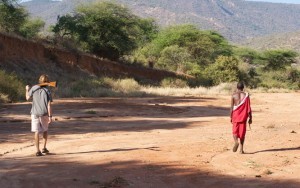 Walking safaris in Africa are good for the soul, it’s a fact – getting back to basics with a private safari guide, exploring some of Africa’s most unique and game rich areas, all on foot. It feels natural and authentic and never will you get a better view of the bush than when on foot. If you really want to get away from the crowds and explore areas which others haven’t, then on foot is the only way to do it. Walking safaris are the preferred safari option for most guides which means the walking safari operations often attract a much higher quality of safari guide whose knowledge of the bush will be unrivalled.
Walking safaris in Africa are good for the soul, it’s a fact – getting back to basics with a private safari guide, exploring some of Africa’s most unique and game rich areas, all on foot. It feels natural and authentic and never will you get a better view of the bush than when on foot. If you really want to get away from the crowds and explore areas which others haven’t, then on foot is the only way to do it. Walking safaris are the preferred safari option for most guides which means the walking safari operations often attract a much higher quality of safari guide whose knowledge of the bush will be unrivalled.
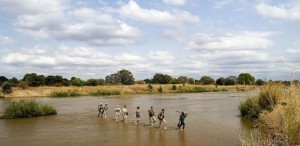 Walking safaris take place all over Africa and some of our favourites are those that walk out from a luxury lodge and meet a lantern lit fly camp for the night, before walking back. This means you don’t have to commit to days spent walking and roughing it, but can enjoy the feeling of complete remoteness before heading back to your luxury camp, which in itself will be in a remote and magical location. Sand Rivers in the Selous offer fantastic walking safaris across hills and through savannah where vehicles cannot go. Chada Katavi in Western Tanzania also offer magical fly camping, in an area which is bigger than most counties and only has one luxury camp – it doesn’t get anymore wild.
Walking safaris take place all over Africa and some of our favourites are those that walk out from a luxury lodge and meet a lantern lit fly camp for the night, before walking back. This means you don’t have to commit to days spent walking and roughing it, but can enjoy the feeling of complete remoteness before heading back to your luxury camp, which in itself will be in a remote and magical location. Sand Rivers in the Selous offer fantastic walking safaris across hills and through savannah where vehicles cannot go. Chada Katavi in Western Tanzania also offer magical fly camping, in an area which is bigger than most counties and only has one luxury camp – it doesn’t get anymore wild.
 Zambia is also famous for walking safaris and all of the properties there offer walks from the camps, or walking with a mobile camp which is moved by your private staff during the day while you are walking. You get to take in the smaller things, which make the ecosystem around you survive, and often have peaceful and quiet experiences with wildlife, which are humbling and life changing.
Zambia is also famous for walking safaris and all of the properties there offer walks from the camps, or walking with a mobile camp which is moved by your private staff during the day while you are walking. You get to take in the smaller things, which make the ecosystem around you survive, and often have peaceful and quiet experiences with wildlife, which are humbling and life changing.
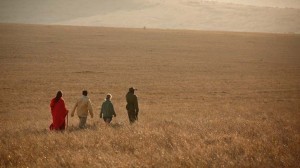 Luxury camps and lodges can no longer simply offer game drives, it is the freedom to explore the bush which is really appealing to people and this is shown by the number of camps which now offer walking. Sometimes you will come around the corner to find a fully laid out bush breakfast, delicious after a hard walk. Or a sundowner spot laid with lanterns and a cold beer or coca cola. Walking is so peaceful and the game reacts calmly and naturally to your presence. Walking with the expert guides is fantastic and in Kenya, Tanzania, Botswana and Namibia there is the chance to walk with ancient tribespeople whose knowledge of tracking and the bush is mesmerising.
Luxury camps and lodges can no longer simply offer game drives, it is the freedom to explore the bush which is really appealing to people and this is shown by the number of camps which now offer walking. Sometimes you will come around the corner to find a fully laid out bush breakfast, delicious after a hard walk. Or a sundowner spot laid with lanterns and a cold beer or coca cola. Walking is so peaceful and the game reacts calmly and naturally to your presence. Walking with the expert guides is fantastic and in Kenya, Tanzania, Botswana and Namibia there is the chance to walk with ancient tribespeople whose knowledge of tracking and the bush is mesmerising.
About the Author: Rose Hipwood lived, loved and worked in Africa for 7 years before founding The Luxury Safari Company four years ago. Specialising in off the beaten track luxury safaris you can rest assured that you will always have access to Africa’s most exclusive properties, the best safari guides and unrivalled first hand knowledge of Africa.
The post Zambia: Walking Safaris are Good for the Soul appeared first on We Said Go Travel.
On the banks of Ganga in Rishikesh, India
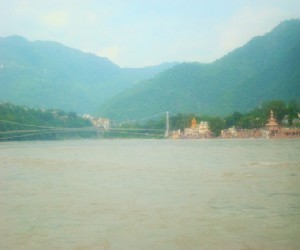 On the banks of Ganga in Rishikesh
On the banks of Ganga in Rishikesh
Rishikesh is a religious place at the foothills of the Himalayas in northern India. The great river Ganga (Ganges) flows through Rishikesh. Hindus worship the Ganga and believe that its water is blessed. They also believe that taking a bath in the river Ganga can wash away all their sins. You can find several people filling empty bottles and cans with Ganga water to take back with them to their homes.
Although the single most important feature of Rishikesh is the river Ganga, the place is also popular for several other reasons. Rishikesh is the gateway to Kedarnath and Badrinath, which are popular religious places of Hindus. Rishikesh is also famous for adventure sports, as it has several adventure camps that conduct river rafting, bungee jumping, and rock climbing along the banks of the Ganga.
I have visited Rishikesh a number of times, as it happens to be one of the favorite vacation destinations of my family. Every year, I visit Rishikesh at least twice, if not more. In 2013 also, I visited Rishikesh twice. I enjoy the long walks along the river, bathing in it, and then lying on the white sand on the banks of the Ganga. I also love the evening prayer in front of the Parmartha Niketan, a famous ashram with a huge statue of Lord Shiva in the middle of the river. After the prayer is over, many people light small earthen lamps or diyas, place them along with flowers on big leaves that they set afloat in the river.
Though I love doing all this, my favorite pastime in Rishikesh is to sit silently on the rocks by the side of the Ganga, with my legs dipped in the cold water, and listen to the sound of the river. Its music seems more beautiful to me than the sound of a guitar. When I am sit there and watch the river flow by, I feel at peace and feel inspired to do the best that I can.
The river Ganga inspires me because I think its journey is similar to our life. Ganga originates from the Gangotri glacier in Uttarakhand and flows thousands of kilometers to finally merge with the Bay of Bengal. In this long journey, the flow of the river keeps changing. At times, the flow is very fast, and at times it is very slow. The journey of our life is also very long. In this long journey of life, we face many problems and we overcome most of them. But some problems seem hard to face. When the obstructions of the river increase, the river has barely any flow. However, the river does not stop. It continues to flow through whatever space it finds and overcomes the obstructions drop by drop. We also have to do the same thing. Step by step, we can finally overcome our problems, however big they might be.
With change in season, the water level in the Ganga sometimes becomes very low while at other times, during and after the monsoons, the river is flooded. Similarly, in our life also, we sometimes feel down and depressed, whereas in some other times, we feel happy and blessed. The river Ganga finally reaches its delta and we finally reach the end of life’s journey. We all know that one day we have to face death but we don’t know what happens after death. Indian mythology says that all of us have to go through a cycle of birth and death and then rebirth. If a person has done good things in life, then after death he or she becomes free from this cycle and simply merges with God. Just as the river Ganga finally merges with the sea.
Rishikesh is religious and sacred for many people, but for me it is much more than that. Rishikesh, and especially the river Ganga, is like a Guru to me that helps me understand the purpose of life and inspires me to live life in a meaningful manner.
About the Author: Aakash Pandey is 13 years old and studies in Class VII at Presidium, Indirapuram. He loves writing short stories, travel accounts, and articles on life.
Thank you for reading and commenting. Please enter our next Travel Writing competition and tell your story.
The post On the banks of Ganga in Rishikesh, India appeared first on We Said Go Travel.
March 11, 2014
The Conch Republic, USA
At the southernmost end of US Route 1 and usually under sunny skies lies the enchanting isle of Key West. Known for its nearly perfect weather, Key West not only attracts artists, writers and vacationers, but especially those who want to live on the fringe of society, vagabonds and others with wanderlust. Among the many famous residents and presidents who resided there are Ernest Hemmingway, Shel Silverstein, Tennessee Williams, Jimmy Buffett, Kelly McGillis, Judy Bloom, Harry Truman, Mel Fisher, John James Audubon, Winslow Homer, Robert Frost and many others.
What is it about the end of the road that is so attractive? Perhaps it is the charming town, the bohemian architecture, the unspoiled beauty of the sparkling aqua sea, the authentic Cuban cuisine, or the lure of the laissez-faire attitude that is prevalent throughout the city that is so alluring. Whatever it is, it is so seductive that people either move there or keep coming back. My husband and I have visited six times and are always eager to return! We’ve been enamored with Key West since our first trip, for it is an experience that adds adventure and spice to our lives!
Called Cayo Hueso, or “bone island” in Spanish, because of the stacks of Indian skulls and the plethora of bones found littering the ground, Key West’s history is rich with vibrant stories of interesting people, pirates, triumphs, tragedies, traditions, and customs. You can learn much about the history of Key West by touring the cemetery, visiting the many museums, historical buildings and landmarks, taking a conch train ride, or if you dare, climbing aboard the Trolley of the Doomed for a haunted history tour.
There are plenty of natural treasures to explore by fishing, boating, snorkeling, scuba diving, getting a bird’s eye view in an ultralight or biplane, and hiking along the beaches and state parks. You can combine your love for history, activity, and nature by taking a sea plane to the Dry Tortugas National Park to explore Garden Key Light and Fort Jefferson, view the unspoiled beauty of the shore, watch birds, and snorkel along the undisturbed coral reefs.
Mallory Square is a popular place to gather nightly for Sunset Celebration and to appreciate the end of another day in paradise. Though there are artists, crafters, psychics, and food carts selling their wares, the main attractions are the street performers that woo the crowd with their latest tricks including jugglers of dangerous and flaming objects, tightrope walkers, sword swallowers, gymnasts, animal acts, and more.
If you’d prefer a quieter and more secluded spot to watch the sunset, the top of the La Concha hotel offers excellent views!
A sunset sail on a schooner is another fine way to relax at the end of a busy day. One of the best things we ever did was to take a sunset sail on the Schooner Wolf where we met Rich In Spirit McKay whom we befriended. Rich came to the keys decades ago and never left. He is a musician, songwriter and activist that inspires people to live more positive, joyful, sparkly lives and regularly plays on the Wolf. The Schooner Wolf is the flagship of the Conch Republic. It leads the battle in the reenactment of the secession of the self-declared Conch Republic from the United States. The secession occurred on April 23rd, 1982 in protest of the US Border Patrol’s roadblock along Route 1 which severely disrupted tourism. Captain Finbar Gittelman, owner of the Wolf, was the impetus behind the reenactment of the battle which now takes place annually and is part of a week long festival. Their slogan is “We seceded where others failed.”
No matter what you choose to do, you needn’t feel inhibited in Key West! Everyone is out for a good time and almost anything goes! Wear what you want, drink as much or as little as you want, eat some good food, hear great music, dance, explore, indulge, let loose and enjoy yourself! The motto of the city is “One Human Family,” the biggest vibes are pleasure and entertainment, and a tangible, creative energy abounds! Maybe that is why so many artists and diverse people congregate and celebrate in Key West.
To help keep joy first and foremost in my mind even after we left the Keys, I purchased an inspirational magnet from one of the artists at Sunset Celebration with a quote by Marcia Wieder that reminds me of this special place: “It is essential to our well-being, and to our lives, that we play and enjoy life. Every single day do something that makes your heart sing.”
About the author: Laurie Wolfrum is an unschooling parent who shares her life with her husband Jim and their four children in mid-coast Maine. She enjoys frequenting the shore, exploring new places and revisiting favorite haunts, especially if there is a lighthouse involved.
Thank you for reading and commenting. Please enter our next Travel Writing competition and tell your story.
The post The Conch Republic, USA appeared first on We Said Go Travel.
Greece; A Timely Muse
 The significance of time is time itself. To waste time is to waste that which cannot be regained. Furthermore, to live life with regrets is to deny its brilliance at permitting much needed do-overs. -Self
The significance of time is time itself. To waste time is to waste that which cannot be regained. Furthermore, to live life with regrets is to deny its brilliance at permitting much needed do-overs. -Self
This I know all too well. Each new day being announced by the intrusive wail of the alarm clock, never failing to remind me of my measly surroundings. Ever since migrating here to the United States over a decade again I have seldom gone out of state, so it no wonder that these four walls of this compact Brooklyn apartment aim to confine, imprison and stifle my lifelong desire to travel the world starting with Greece. These bland neighborhood backdrops, such as the projects adjacent to my living quarters desperately want me to believe that I am entitled only to what lies before me and little else. It wants me to sink down into my spirit that because I am not financially endowed, my dreams to see outside of my routine settings are somewhat ludicrous if not at all impossible.
And yet defiantly I dream. I feverishly dream of Greece and the moments in which I will immerse myself into its breathtaking atmosphere without any regrets whatsoever. Greece in itself is its own muse and time a commodity. A never ending vessel and basin of inspiration, where the past and present dance enticingly hand in hand. An open canvas for all forms of arts to find conception. I can already envision myself in the grandeur called Greece. I visualize myself being elevated until I am given a bird’s eye view of the Ionian Islands. Its transparent waters, lush greens and sandy earthy complexion beckon to me and instantly I am lured in; much like the sirens, Circe and mermaids of ancient Greek mythology who ensnared the sailors, except I come free will.
That being said, who needs television when one can listen to the exotic myths being spunned from locals who have learned them well, from the mouths of their very own descendants, for both religious and recreation purposes. No modern form of enterntainment can rival to the tale of Hermes the Olympian God of Travel or Odyssey, another travel enthusiast. On another occasion I can see myself too vividly descending along the Corinth canal. Its narrow walls enveloping me and yet it does not pose a threat because unlike my previous domain, it does not try to suffocate me. Further still I can catch a glimpse of myself in Athens. A trip to Greece always merits and is never quite complete without a visit to its metropolis. Athens is the central point. A key site for innovation and thought where Greece’s history spill full to the brim and where you are given a rare chance at unparelled beauty.
Only in Greece am I presented with the opportunity to admire nature and in unison ponder its meaning in depth. Only there in its bosom can I simultaneously be a tourist as well as a philosopher, such as the great Socrates, as I imagine myself as Colossus of Rhodes, allowing myself to rise to new heights, standing between what I knew then and the knowledge which still remains to be obtained.
Greece to me represents no restraints. It represents freedom, awe as well as creativity. In Greece, time is much more precious than currency. Each hour more sacred than the last. Although at this instance, I am limited to these four walls and monotonous locale, one day in the near future Greece and I will have the chance to flirt and I will forever cherish the time when I will lose myself in time in a land of paradise.
About the Author: My name is Liza Philidor and my aspiration is to travel the world, starting with Greece. I want to expand my mind as well as locale.
Thank you for reading and commenting. Please enter our next Travel Writing competition and tell your story.
The post Greece; A Timely Muse appeared first on We Said Go Travel.
Connection-Hong Kong
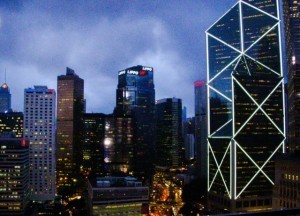 John Le Carre in The Honourable Schoolboy writes “When you leave Hong Kong,” …”it ceases to exist.” To me Hong Kong never ceases to exist, it remains an inspirational enigma even after five years of stay. We, my husband and me, came to Hong Kong in 2008, initially for a year, but the year rolled into two, three and beyond and we would find ourselves queuing at the Immigration office to get our extensions stamped. There is no single reason for taking root in this neatly packaged Island city boasting of a multi- dimensional scintillating façade of concrete and lush greenery.
John Le Carre in The Honourable Schoolboy writes “When you leave Hong Kong,” …”it ceases to exist.” To me Hong Kong never ceases to exist, it remains an inspirational enigma even after five years of stay. We, my husband and me, came to Hong Kong in 2008, initially for a year, but the year rolled into two, three and beyond and we would find ourselves queuing at the Immigration office to get our extensions stamped. There is no single reason for taking root in this neatly packaged Island city boasting of a multi- dimensional scintillating façade of concrete and lush greenery.I came to Hong Kong with expectations of finding my shoe size. School Geography lessons taught us that Chinese women were synonymous with ‘lotus feet’ and I am size 4. First revelation was that there are no ‘tiny feet’ sizes in Hong Kong markets, except for kids, and the custom of foot binding was long extinct. Second surprise was that Chinese cuisine was more than Manchurian Chicken, Chow Mien and Hot & Sour soup. I followed the distinctive Hong Kong smell, ‘perfumed fishy’ as a friend put it, through alleys, neighboring islands and restaurants discovering finger-licking Fish balls dipped in sauce, the hang-man bloated ducks, fried chicken claws, succulent dim sums and slurpy soup noodles. The list now scrolls down to Bok Choy, Choy Sum, Chao Daub Fu or smelly Tofu, crab cakes, moon cakes, Dragon fruit, Persimmons, Mangosteen and the nose-scrunching Durian.
Not everything is perfect: the unblinking faces in lift lobbies, the pushy crowds of the MTR, the often silent walk to JUSCO, WELLCOME, PARK & SHOP (stores)and back without uttering a syllable, the guttural rudeness of fruit sellers at wet market stalls, the pestering sales peddlers of ‘genuine fake’ watches and purses, too many people waiting for taxis around midnight on Nathan Road, the ‘No cheap’ snide comments of shop assistants of brand showrooms because you happen to be from the Sub-continent, the ‘I-stay-in-a-beachside villa’ snooty comment of expat permanent residents.
The list expands and subtracts as I move around Kowloon, Hong Kong, the neighboring islands, New Territories’ villages for shopping, hiking, literary and cultural activities; watching seniors twirl to ‘Sugar Sugar Honey Honey’ in neighborhood parks or visiting Temples-splendid in serenity; while watching fireworks illuminate the night sky on Chinese New Year or swaying to pulsating drum beats during Dragon Boat races; during mute shopping spree in Wet markets as I get coins plucked from my hand and a bag looped on my fingers; riding the tram, ‘the slow motion mechanical rickshaw ’ to the British relic ‘Western Market,’ a red beacon in the traditional ambiance of Sheung Wan.
In five plus years Hong Kong unfolds into quirky quilt, patch-worked with frisky ferry rides across the fast reducing water way, kaleidoscopic shopping malls and multiplying vertical constructions in ‘who is tallest’ mode and responsible for vertigo, streamlined air-conditioned walkways and numerous eating places metamorphosing with drop of chopstick, the ‘couldn’t care less attitude’ of locals and jostling Mainlanders, the land grabbing helpers sprawled in open spaces and parks, the tenacious seventy year old, bent back, pushing a cart stacked with cardboard boxes through crowded pavements, seniors swimming in the cold waters of Hung Hom Bay, the willowy model selling whitening cream on posters pasted all over the city, the high-decibel bus passengers in conversation or argument, the poky umbrellas rain or sunshine, the flora and fauna and the hikes.
“Hong Kong is a female in labor, writhing and beautiful” and I suppose it is this anticipation of something new or surreal that makes expats, from different corners of the globe, stay on. The British set foot in Hong Kong in 1841 and enamored by the commercial and natural assets of ‘The Fragrant Harbor’ lingered on till they had to return the land to China in 1997. “Fragrant Harbor,” is a sobriquet derived from the scents of trees and flowers that once adorned the hills and shores of the Island. The flowers and trees are still there, but out-numbered and out- swamped by buildings, traffic fumes, odorous flavors and cigarette smoke.
When someone asks me ‘Don’t you miss your country’ my answer is that I would rather “find yourself in an Asian noodle house at 4 am. That you make your offering at the temple of existence. That you dine atop of a one hundred story building. That you ride a ferry to some small island. That you learn to play Mahjong. That you sing Madonna at seedy Karaoke bar. Most importantly, that you shed your illusions. Of yourself. And of what you assume otherness to be”.*
*from a blog on Hong Kong
About the Author:Indra Chopra is a freelance writer and Blogger.
Thank you for reading and commenting. Please enter our next Travel Writing competition and tell your story.
The post Connection-Hong Kong appeared first on We Said Go Travel.
March 10, 2014
Pokhara, Nepal: A Mystic Place To Be
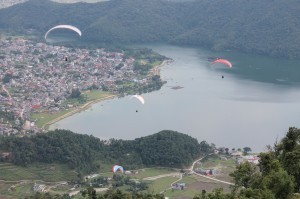 Since I was away from my home country Nepal for many years, many of my foreign friends had asked me about mountains and Himalaya of Nepal. But, I did not have the solid answer that how it would look like. But as soon as I came back to my home country I packed my bag and headed for Pokhara, which is paradise for many nature lovers. I caught a local bus from Kathmandu at around six in the morning in the month of October. There were dozens of flights also available from Kathmandu for round trip fare of around 70 dollars but I chose road transportation so that I could enjoy scenic beauty of mountains and hills.
Since I was away from my home country Nepal for many years, many of my foreign friends had asked me about mountains and Himalaya of Nepal. But, I did not have the solid answer that how it would look like. But as soon as I came back to my home country I packed my bag and headed for Pokhara, which is paradise for many nature lovers. I caught a local bus from Kathmandu at around six in the morning in the month of October. There were dozens of flights also available from Kathmandu for round trip fare of around 70 dollars but I chose road transportation so that I could enjoy scenic beauty of mountains and hills.
Being a gateway of trekking paradise like Annapurna circuit, Annapurna base camp, lying north of it, Pokhara easily lures visitors from around the world. I reached at around 11 AM in 5 hours bus trip.
As it is the tourist hub of the country, it was easy to get accommodation either in budget or luxurious hotels. I chose a single room for 6 hundred Nepalese rupees (6 dollars) which was cozy and decent one. It is true that you can spend a day in as low is in 16 dollars in Pokhara, which is really inexpensive. Pokhara is also considered the dream destination for backpackers.
Bikes on Hire, Taxis were easily available in various parts to move around including local buses. It might take you few days to enjoy all the natural beauty of Pokhara as it offers the best sightseeing, hiking, boating, paragliding and Rafting/Kayaking spots.
Pokhara is a significant tourist destination in Nepal which lies between the great Himalayas and Mahabharat range in the central region of the country. It is the only Place in the world from where one can enjoy the magnificent view of Mountains having elevation above 8000 meters while sitting below 1000 meter above sea level. Out of the 14 highest mountains of the world, which are known as eight thou sanders having elevation above 8000 meters, Annapurna, Dhaulagiri and Manasulu can be seen from Pokhara. It is an enchanating city nestled in a tranquil valley, which is also gateway to the world famous Annapurna circuit trekking trail.
Several hills and hillocks scattered around Pokhara valley are destination for day hikes Offering different tastes of nature by each of them. Kahun hill, Sarankot, Kaskikot, Naundanda, Australian Camp, Dhital, Rupakot, Mattikhan, Nirmalpokhari, Bharatpokhari, Kalikasthan, Armalakot, Dhampus are some hill stations from where you can enjoy local culture, sunrise, sunset and panoramic mountain view.
Paragliding from the hill of Sarangkot can be a lifetime experience for all travelers. The mountains loom over to you on your north and below you the landscape is dotted with paddy fields and hamlets. Probably that’s why Pokhara is amongst the hotspots for Paragliding in the world. The flying season commences from September through February. November and December being the best months. Sarangkot is graded as one of the top five-paragliding destinations in the world.
If you have a dream to fly like birds, go to Pokhara and try Ultra light Flights. Leave your woes behind on earth, soar to heights, bath in the clouds, reach out for the mountain sand kiss the azure sky as you fly across. This also offers opportunities to take some of the most breathtaking views. There are also Mountain Flights available if you want to see the tallest Himalays in Annapurna region. Mountain flight is also interesting for even those who have done their treeking. It gives a completely different experience than trekking. It gives a chance to see the large range of massive mountains in on glance. Other attcations of Pokhara are the lakes it has. Phewa lake, the second largest lake in Nepal can be seen very beautiful in the lap of mount Machhapuchhre. There are many other lakes like; Mahendra lake, Begnas lake can be genuine place for boating, Kayaking, sun bathing, fishing, bird watching, swimming. Pokhara has also been an ideal place for creativity. Many writers and poets have found creation in this mystic place.
International Mountain Museum, Regional Museum, Annapurna Museum, Gurkha Memorial Museum which document mountaineering and mountaineers are also must visit places in Pokhara. Tal Barahi Temple, Kedereshwor Temple and Buddhist Monastery, World peace Pagoda are also mind-blowing spots of Pokhara.
About the Author: Sunil Dhungana is a travel enthusiast; I have travelled four continents so far. I like to collect travel experiences as much as I can.
Thank you for reading and commenting. Please enter our next Travel Writing competition and tell your story.
The post Pokhara, Nepal: A Mystic Place To Be appeared first on We Said Go Travel.
Kyoto: The tanuki and the temple
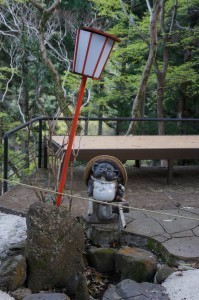 We approached the clearing cautiously, snatching glimpses of the abandoned building’s interior through gaps torn in its sliding screens. There were frayed tatami mats covered in a thick layer of dust and a solitary paper lantern hung half-heartedly from the ceiling, its washi paper yellowed unevenly by prolonged exposure to the sun.
We approached the clearing cautiously, snatching glimpses of the abandoned building’s interior through gaps torn in its sliding screens. There were frayed tatami mats covered in a thick layer of dust and a solitary paper lantern hung half-heartedly from the ceiling, its washi paper yellowed unevenly by prolonged exposure to the sun.
The evening air was still, without a hint of a breeze. It was clear that, apart from the occasional bird or squirrel, Robert and I were the only sources of movement in that quiet portion of forest, hidden high in the mountains of Kyoto. Every snap of a twig or rustle of leaves sent goosebumps rocketing onto the skin of our arms.
“I don’t want to disturb anything,” I whispered, imagining spirits gathering once the sun had set, equipped with spectral casks of sake for that evening’s festivities. But despite my over-active imagination, as we looked back at the abandoned building before rejoining the mountain path, it was abundantly clear that any sounds of merriment (human or otherwise), had long since dissipated into the chilly air.
We were treated to picturesque views of the surrounding valley on our way up to Jingo-ji temple. Huge trees with vividly green canopies and dark, gnarled trunks stood sentinel as we passed. In the distance an azalea forest bloomed, as intensely purple as the oncoming dusk and all around us lay great carpets of moss, wrapping the earth in a delicate shroud.
A red lantern bobbed into view as we reached the top of the stone steps. It leant precariously to one side and looked as though a strong gust of wind would knock it over. Yet despite its garish colour, my gaze quickly came to rest below it, where a statue of a tanuki stood. I felt it watching me through small, dark eyes.
Though I’d heard of tanukis once or twice before, I couldn’t recall what kind of place the raccoon-dog held in Japanese folklore. Was he there to help us on our path to the temple, or was he intent on distracting us from our journey? The intelligence that seemed to resonate from his black eyes contradicted the foolish grin spread across the lower half of his face. The more I looked, the more uncertain I became.
“I don’t trust him,” I said finally, speeding towards the entrance of the temple. But as we got closer we saw that the tall wooden gates were shut ― we had arrived too late to visit the grounds. Somewhere behind me I knew the tanuki stood, grinning, his fat white belly as round as the Moon.
With our original plan scuppered we sat as close as we dared to the rock face at the edge of the trail and gazed down at the tops of the many trees we’d passed on our ascent. A few crows flapped noisily through the air to our left, their guttural cries fading into the distance before I had time to even focus the camera.
Sat amongst that remarkable congregation of nature, the importance of time seemed to weaken with every beat of a bird’s wings, loosening its grip on us as surely as the wind released blossoms from their branches. On the mountainside we were witness to events that were at the same time ordinary and extraordinary, that were unaffected by our arrival and that would continue to occur long after we had departed. Our insignificance was strangely inspiring.
Although we’d leave no trace of ourselves behind, I smiled at the fact that we were fortunate enough to have been there, in that moment, enveloped in the wondrous sights and sounds of Japan’s nature in early bloom, half a world away from home.
When the staff at the ryokan asked if we’d enjoyed our visit to the temple later that evening, disappointment at it’s closure couldn’t have been further from my mind. Not knowing enough Japanese to enquire about the tanuki and finding ourselves with some spare time before dinner, I quickly searched the internet for information on the mysterious creature. The phrase ‘feigned ignorance’ appeared on Wikipedia.
I knew it.
About the Author: Georgina Miller lives in the UK and has a deep love for all things Japan. She knows she wants to be a writer, but isn’t sure which genre she’ll end up focussing on. For now, she is simply enjoying writing in various forms. She holds a joint degree in English Literature and Journalism.
Thank you for reading and commenting. Please enter our next Travel Writing competition and tell your story.
The post Kyoto: The tanuki and the temple appeared first on We Said Go Travel.
Vietnam: Eco and Ethno-tourism for Sustainable adventures
Eco and Ethno tourism: Sustainable adventures for the Traveller on a Budget
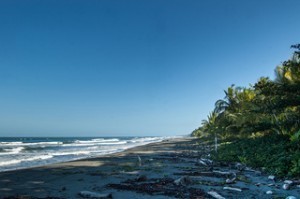
Photo Credit: World Wide Gifts
For most of us, finance is the driving force for the choices we make when we jet off on our next holiday. While the cheap resort package will always prove popular, two recently emergent trends in shopping for bargain holidays are eco-tourism and ethno tourism, and some might argue these new ways to get away from it all make for a more worthwhile travel experience than the most luxuriant of escapes.
With growing concern for the heavy carbon footprint of travel, and the effects of commercial tourism, governments have started to take responsible steps to encourage visitors to less economically robust places, destinations of exceptional environmental beauty or with vulnerable habitats. Diversifying into tourism can often be of long term advantage for many areas of the world, providing sustainable cash flow in the place of more destructive sources of revenue like deforestation and hunting
Not only do these steps benefit the destination, there are also some distinct advantages for the traveller. Eco-tourism is all about preserving natural beauty, enhancing existing assets and showcasing the uniqueness of a place. One renowned example is the rainforest of Costa Rica, the ‘poster child’ of the eco-holiday. Its initial campaign was about the encouragement of nature tourists to visit and explore is vastly biodiverse habitats. Now, it’s one of the most successful and beautiful eco-tourist resorts in the world.
Ethno-tourism differs simply by focussing more on people than environment, and often is aboutimmersion in the everyday life of the destination country. For example in Hoi An, Vietnam, tourists can learn traditional Vietnamese cookery, spend the day growing herbs at the Tra Que herb village, take up yoga, learn the ancient art of silk making, head to the carpentry or pottery village or the local handicraft workshop, or spend a day fishing at the Thanh Nam Fishing Village.
You can also give something back without putting your hand too deep in your pocket. There are ways of off-setting the cost, and carbon footprint of visiting some of the more remote eco-tourist destinations. Opportunities to volunteer your help abound, and meaningful activities range from working on ecological design in Israel and repairing hiking trails in Montana to helping conserve turtles on the beaches of Costa Rica and dolphins in Greece.
Another way to travel more immersively on a budget is by way of the Worldwide Opportunities on Organic Farms (WWOOF) initiative.
For a small membership fee, members can travel and work on host farms, reaping free accommodation and food while learning about organic lifestyles and, in some cases, forging lifelong friendships. Destinations are becoming widespread, and opportunities everywhere from Hawaii to Japan can be found on the WWOOFing website.
About the Author: David Waterlow is a blogger, travel writer and a keen supporter of eco-travel ideas. When he’s not writing, he’s most likely to be found in Elgin, Scottish Highlands, where he runs a self-sustainable organic farm.
The post Vietnam: Eco and Ethno-tourism for Sustainable adventures appeared first on We Said Go Travel.
We Said Go Travel
We Said Go Travel is a global community of over sixteen hundred writers with articles from every continent.
Stories are shared with photos and video from a perspective of the transformative power of travel. We Said Go Travel has hosted live and online events as well as travel writing contests around the world. ...more
- Lisa Niver's profile
- 57 followers




